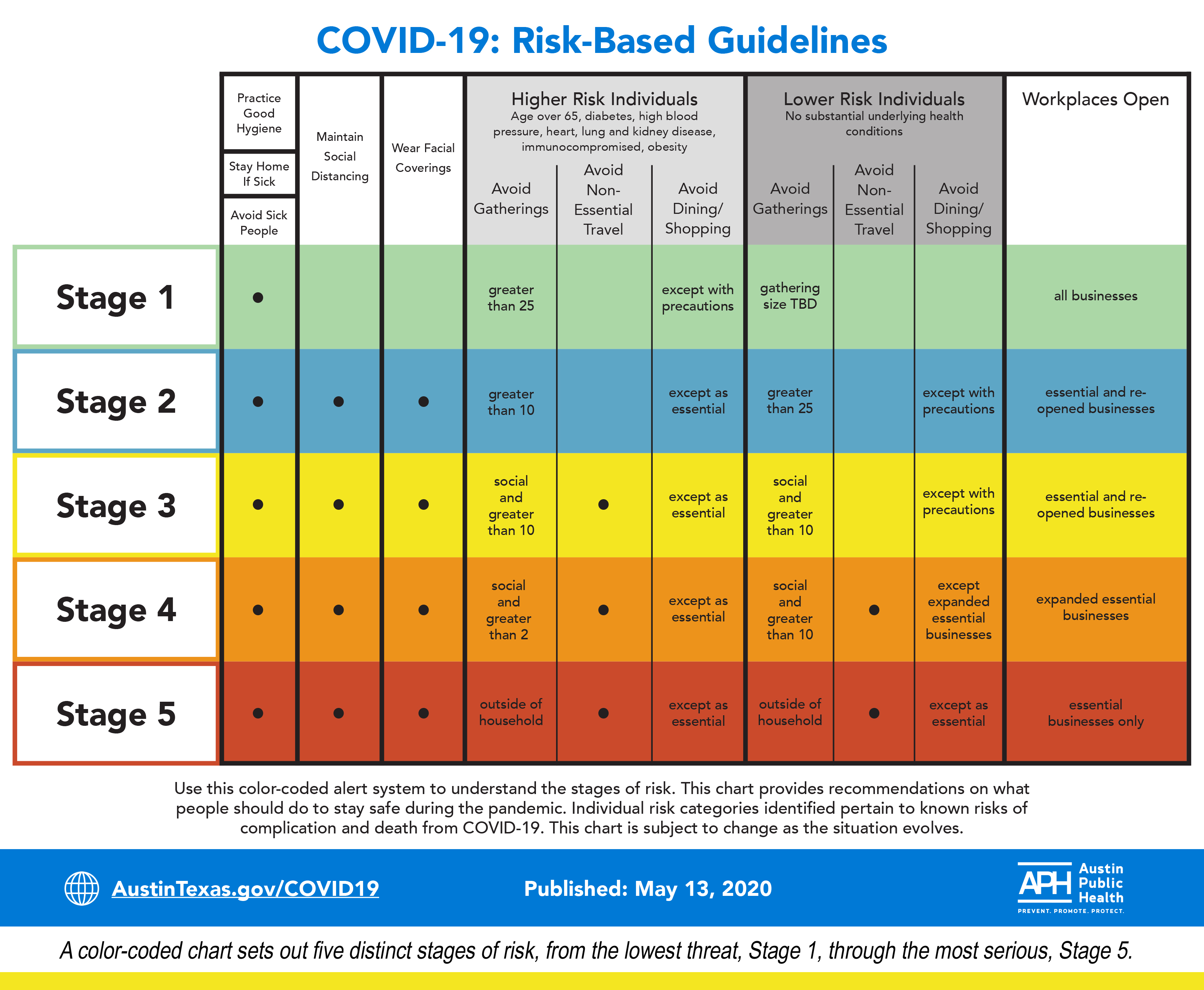
Dear Colleague,
Austin Public Health (APH) has published a color-coded chart to help residents of Austin-Travis County understand the stages of risk and provide recommendations on what people should do to stay safe during the COVID-19 pandemic.
The new risk-based guidelines set out five distinct stages of risk, from the lowest threat, Stage 1, through the most serious, Stage 5, along with recommended behaviors for each stage.
Austin-Travis County is currently in Stage 3 risk category.

For lower-risk individuals, defined as those with no substantial underlying health conditions who have a lower risk of complication and death from COVID-19, the recommendations are as follows:
Stage 1: Practice good hygiene, stay home if sick, and avoid other people who are sick. APH is working on recommendations for maximum sizes of gatherings. Individuals are advised they are safe to return to work at all businesses.
Stage 2: Includes the recommendations for Stage 1 and adds: Maintain social distancing and wear fabric face coverings in public. Individuals are urged to avoid dining and shopping except with precautions, and to avoid gathering in groups of more than 25 people. They are advised they are safe to return to work at essential and reopened businesses.
Stage 3: Includes the recommendations for Stage 2 and also urges individuals to avoid non-essential travel, all social gatherings, and any gatherings of more than 10 people.
Stage 4: Includes the recommendations for Stage 3 and advises individuals they are safe to return to work, and dine and shop, only at “expanded essential businesses”. This category will be defined shortly.
Stage 5: Includes the recommendations for Stage 4 and urges individuals to avoid all gatherings outside of the household and avoid dining and shopping except as essential. In this stage it is considered safe to return to work at essential businesses only.
Additional protective measures are recommended for people at higher risk, namely those aged over 65 or people with diabetes, high blood pressure, heart disease, lung disease, kidney disease, obesity, or those who are otherwise immunocompromised. For example, higher-risk individuals are urged to avoid dining and shopping except with precautions, and avoid gatherings of more than 25 people, even at the lowest level, Stage 1. As the stages progress from 1 through 4, higher-risk individuals are advised to limit the size of their gatherings, and their dining and shopping, to a greater extent than lower-risk individuals. However, by Stage 5, all individuals are advised to limit their activities and exposure to the same degree, whatever the condition of their health.
View the Risk-Based Guidelines HERE.
APH is currently exploring the most effective indicators to help determine the level of risk in the local community. Provisional triggers are being modeled based on the number of hospitalizations because of their general correlation with numbers of cases, use of ventilators, deaths, and availability of effective treatment and vaccination.
Based on an assessment using provisional modeling, Austin Public Health currently considers Austin-Travis County to be in the Stage 3 risk category.
This means individuals are currently advised to:
- Practice good hygiene
- Stay home if sick
- Avoid other people who are sick
- Maintain social distancing
- Wear facial coverings
- Avoid all social gatherings, and any gatherings of more than 10 people
- Avoid dining and shopping except with precautions (lower-risk individuals) or except as essential only (higher-risk individuals)
- Avoid non-essential travel (higher risk individuals)
- Return to work places in essential and reopened businesses only
As person-to-person interactions increase following the Texas Governor’s decision to lift restrictions on a range of high-contact businesses, services and other activities, local risk levels will continue to be reassessed over the coming weeks as new data becomes available.
While the new guidelines are primarily designed as a resource to help individuals modify their behavior to protect themselves and others against transmission of COVID-19, they will also be used to inform APH recommendations around when restrictions on gatherings, business operations, and events should be loosened or tightened in the months ahead.
By encouraging a cautious, phased approach to normalizing activity, underpinned by medical data, APH hopes to minimize the risk of a further spike in transmissions that would cause further economic disruption and hardship to the community.
“This is an evolving public health situation and while all of us want life to return to normal, we know that if we drop our guard and take too much risk too soon, we will end up back in a situation with rapidly rising cases, hospitalizations, and deaths. We will also end up with more significant economic and social impact due to renewed restrictions on businesses,” said Dr. Mark Escott, Interim Austin-Travis County Health Authority. “Our risk-based guidelines should help individuals make safe choices as we move to increase our social interactions. The community can be assured our advice will be measured, appropriate, and made on the grounds of public health using the appropriate data. If we do this correctly, we can open up and stay open while also staying safe.”
For additional information and updates, visit www.AustinTexas.gov/COVID19.
